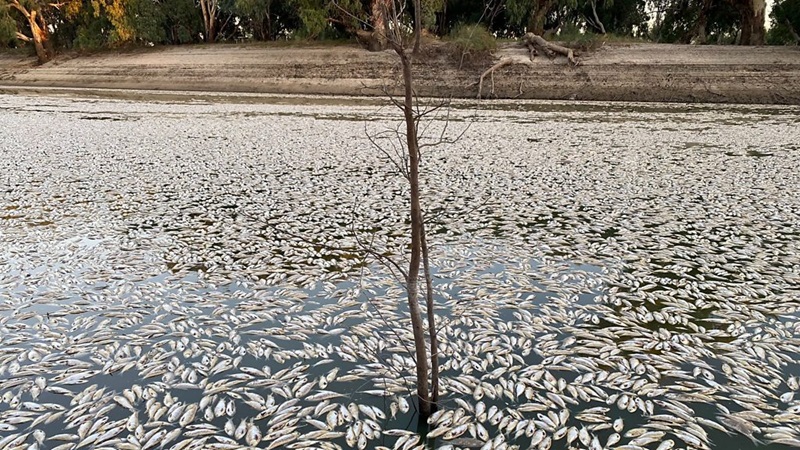
Sarah Marnane
New South Wales Heatwave Leads to Mass Fish Death
Most Read Stories Today
-
Water Scarcity and Artificial Rainfall: The Positive and The Negative Effects of Cloud Seeding, including Health Hazards and Climate Implications.
-
Renewable Energy in Rural Areas: Challenges, Opportunities, and Successful Rural Projects
-
Pakistan's Agriculture at Risk Due to Climate Variability
-
South Africa's Recent Floods: Is Climate Change to Blame?
-
South Korea's floods: root causes and prevention strategies.
-
South Africa: Cape Town, A City Under Fire
-
The Human Cost of Climate Disasters
-
Our Oceans, Our Future: The South African Dilemma of Overfishing
-
Degenerative Impact of Hydrocarbons On The Environment.
-
Sustainable Urban Planning - Copenhagen and the Path to Climate Resilience
A major clean-up effort has been underway on the Darling River near the town of Menindee in New South Wales (NSW), Australia after the region’s most recent heat wave caused the death of millions of fish.
Locals described the smell as “putrid” as millions of fish corpses washed ashore and began to rot during the area's most recent temperature surge. Temperatures near Menindee peaked at 400C. In March, the river rapidly became a mass graveyard for the millions of fish that suffocated and died due to lack of oxygen in the water, influenced by the extreme heat.
The unprecedented death of millions of fish can be detrimental to a river’s delicate ecosystem. Fish play a vital role in maintaining the health and balance of a river. Fish are an important food source for other aquatic life, including larger fishes and birds. Fish also helps in maintaining the balance of food chain by preying on smaller organisms such as zooplankton and insects. When fish disappear from the ecosystem, other species’ populations can suffer as an effect.
Fishes play a vital role in the nutrient cycle of the river. They contribute to the nutrient cycling process by releasing nutrients back into the water through excretion and decomposition. These nutrients, such as nitrogen and phosphorus, are essential for the growth of aquatic plants and algae, which in turn supports the ecosystem by providing food and oxygen for other organisms.
However, when a mass fish death occurs and the fish begin to decompose at once, the nutrient levels being returned to the water spikes and can contribute to poor water quality. The decomposing fish in the Darling River has also caused an algal bloom, which affects water quality. For the Darling River, poor water quality due to a spike in nutrients and lack of oxygen could lead to the death of more fish and other aquatic life. Moreover, apart from rainwater, the residents of Menindee are solely reliant on the water from the Darling River. According to the Centers for Disease Control and Prevention (CDC) “contaminated water and poor sanitation are linked to the transmission of diseases such as cholera, typhoid, and polio”, in extreme cases.
So, what can be done to mitigate the effects of this mass fish death?
The Murray-Darling Basin Authority suggests the following immediate actions:
- Adding water to improve water quality, where possible, in refuge areas to protect native fish
- Using aerators to increase the amount of oxygen in the water (though this only has a small impact)
- Moving fish to key waterholes to protect them during droughts (though fish don't always survive the journey)
- Developing new technologies to increase turbulence in the water and improve water quality
- Developing a water quality threat map to communicate to others where there are locations with potentially poor water quality.
Long-term solutions by the Murray-Darling Basin Authority include; The Basin Plan and the Native Fish Recovery Strategy .
However, this is not the first time that a mass fish death has happened on the Darling River. In 2018, a heat wave led to 30km of dead fish on the river and this pattern is set to continue if rising temperatures are not combatted. Australia is not the only country affected by this phenomenon. In 2018 thousands of fish were removed from the Swiss part of the River Rhine when a rise in water temperatures led to a mass fish death and resulting poor water quality.
Short and long-term solutions must be put in place for the recovery of the fish and the river. But these strategies will fail unless we combat the root of the cause; climate change is causing temperatures in rivers to rise and, in some cases, rivers to begin disappearing altogether. When drought leads to low water levels, fish are unable to escape the high water temperatures and become trapped without enough oxygen to survive.
The most recent mass fish death on the Darling River has once again highlighted the urgent need for action to address the impacts of climate change on Australia and the wider world’s waterways. Heatwaves and droughts are becoming more frequent and severe, putting pressure on already strained river systems. In addition to reducing carbon emissions, measures such as water conservation and the implementation of sustainable land-use practices can help to reduce the strain on rivers and protect their delicate ecosystems.
References
[1] https://www.bbc.com/news/world-australia-65010344
[2] https://www.bbc.com/news/world-australia-65010344
[3] https://www.cdc.gov/healthywater/global/disease-impact-of-unsafe-water.html
[4] https://www.mdba.gov.au/issues-murray-darling-basin/fish-deaths
[5] https://www.mdba.gov.au/basin-plan/plan-murray-darling-basin
[6] https://www.mdba.gov.au/issues-murray-darling-basin/fish-deaths/native-fish-recovery-strategy
[7] https://www.bbc.com/news/world-australia-64992726
[8] https://www.bbc.com/news/world-europe-45102093
Edited by: Muhammad Abdullahi Ibrahim
email:

Terms & Conditions
Subscribe
Report
My comments